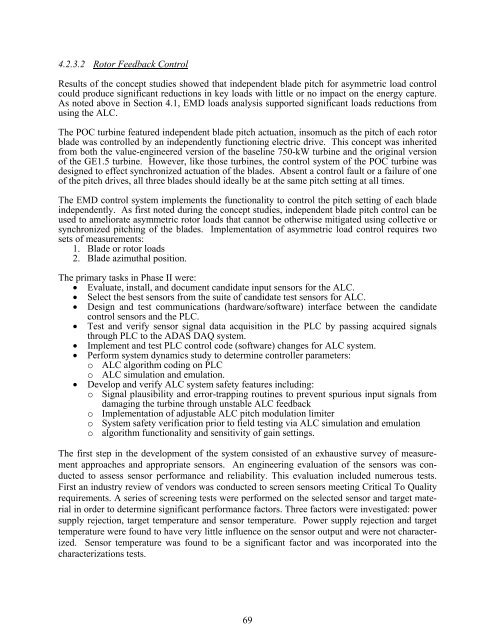Advanced Wind Turbine Program Next Generation Turbine ... - NREL
Advanced Wind Turbine Program Next Generation Turbine ... - NREL
Advanced Wind Turbine Program Next Generation Turbine ... - NREL
You also want an ePaper? Increase the reach of your titles
YUMPU automatically turns print PDFs into web optimized ePapers that Google loves.
4.2.3.2 Rotor Feedback Control<br />
Results of the concept studies showed that independent blade pitch for asymmetric load control<br />
could produce significant reductions in key loads with little or no impact on the energy capture.<br />
As noted above in Section 4.1, EMD loads analysis supported significant loads reductions from<br />
using the ALC.<br />
The POC turbine featured independent blade pitch actuation, insomuch as the pitch of each rotor<br />
blade was controlled by an independently functioning electric drive. This concept was inherited<br />
from both the value-engineered version of the baseline 750-kW turbine and the original version<br />
of the GE1.5 turbine. However, like those turbines, the control system of the POC turbine was<br />
designed to effect synchronized actuation of the blades. Absent a control fault or a failure of one<br />
of the pitch drives, all three blades should ideally be at the same pitch setting at all times.<br />
The EMD control system implements the functionality to control the pitch setting of each blade<br />
independently. As first noted during the concept studies, independent blade pitch control can be<br />
used to ameliorate asymmetric rotor loads that cannot be otherwise mitigated using collective or<br />
synchronized pitching of the blades. Implementation of asymmetric load control requires two<br />
sets of measurements:<br />
1. Blade or rotor loads<br />
2. Blade azimuthal position.<br />
The primary tasks in Phase II were:<br />
• Evaluate, install, and document candidate input sensors for the ALC.<br />
• Select the best sensors from the suite of candidate test sensors for ALC.<br />
• Design and test communications (hardware/software) interface between the candidate<br />
control sensors and the PLC.<br />
• Test and verify sensor signal data acquisition in the PLC by passing acquired signals<br />
through PLC to the ADAS DAQ system.<br />
• Implement and test PLC control code (software) changes for ALC system.<br />
• Perform system dynamics study to determine controller parameters:<br />
o ALC algorithm coding on PLC<br />
o ALC simulation and emulation.<br />
• Develop and verify ALC system safety features including:<br />
o Signal plausibility and error-trapping routines to prevent spurious input signals from<br />
damaging the turbine through unstable ALC feedback<br />
o Implementation of adjustable ALC pitch modulation limiter<br />
o System safety verification prior to field testing via ALC simulation and emulation<br />
o algorithm functionality and sensitivity of gain settings.<br />
The first step in the development of the system consisted of an exhaustive survey of measurement<br />
approaches and appropriate sensors. An engineering evaluation of the sensors was conducted<br />
to assess sensor performance and reliability. This evaluation included numerous tests.<br />
First an industry review of vendors was conducted to screen sensors meeting Critical To Quality<br />
requirements. A series of screening tests were performed on the selected sensor and target material<br />
in order to determine significant performance factors. Three factors were investigated: power<br />
supply rejection, target temperature and sensor temperature. Power supply rejection and target<br />
temperature were found to have very little influence on the sensor output and were not characterized.<br />
Sensor temperature was found to be a significant factor and was incorporated into the<br />
characterizations tests.<br />
69
















